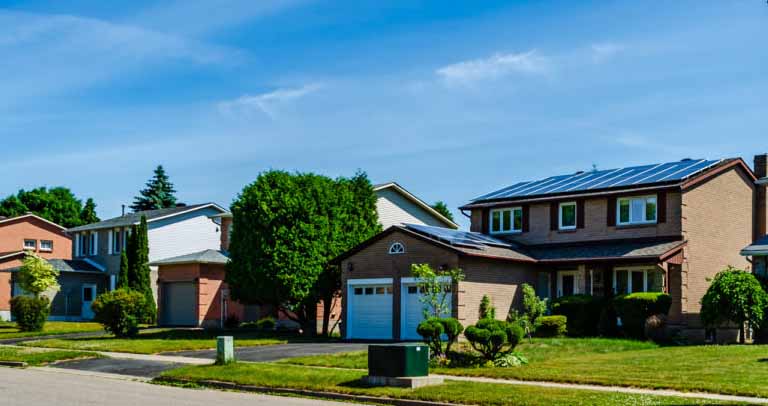Duke Energy and a collective of some of the largest rooftop solar installers in North Carolina have officially come to terms on a modified version of Duke Energy’s Solar Choice Net Metering proposal, one which pushes the utility’s proposed time-of-use rates for net metering customers down the road until at least 2026.
The settlement agreement now means that this finalized version of Duke Energy’s Solar Choice Net Metering proposal, which was originally filed on November 29, 2021, will now go before the North Carolina Utilities Commission for final approval. Once approved, the new net metering tariffs, known as the ‘Proposed Bridge Rate’ will go into effect for customers submitting applications through December 31, 2026, subject to annual capacity caps. Customers who choose to enter a residential solar installation into the Proposed Bridge Rate may do so for up to 15 years, subject to certain limitations.
The settlement also includes a provision under which it can be discontinued if state regulators approve a package of incentives equivalent to at least 60 cents per watt. According to Duke, the Proposed Bridge Rate will allow the company more time to develop said incentive package.
“Duke Energy knows that customer-sited solar is an important part of the future growth of solar in North Carolina,” said Lon Huber, Duke Energy’s senior vice president of pricing and customer solutions. “We believe this phased-in compromise will help the installer industry navigate market changes and adapt to the long-term rate design of Solar Choice.”
The delaying of time-of-use rates for net metering customers, with different net metering rates for peak periods (times when projected electricity demand, and, as a result, costs, are high) and discount periods (times when projected electricity demand, and, as a result, costs, are lower), has been promoted as the big win of the compromise. In practice, the initial proposal would lower net metering rates from between $0.05 and $0.20 per kWh, as it stands today, to around $0.03/kWh. The reason for such a large variance in current rates is that the full retail rate is based on time of use and critical-peak pricing, which fluctuates, depending on the time of day and time of year.
The compromise is a timely one, as the state’s current rebate program is set to expire at the end of the year, even though North Carolina is only required to revisit the current net metering structure some time before 2027. The potential of a five-year gap in net metering policy served to create an environment of urgency for clean-energy focused groups hoping to avoid the industry-harming effects that even a couple of weeks of incentive uncertainty can have on the residential solar market.
The compromise was initially triggered by the intervention of Sundance Power Systems and other North Carolina residential solar installers, all of whom objected to the proposed time-of-use rates. These same groups have said that they will support the incentives being developed by Duke, so long as the incentive package includes the consideration of customer-generated renewable energy that is consumed on site as a demand-side energy resource.
While the compromised proposal has brought on board three of the state’s largest solar installers and previous versions already garnered the support of a coterie of clean energy advocates, including the North Carolina Sustainable Energy Association, the Solar Energy Industries Association, and the Southern Environmental Law Center on behalf of Vote Solar and the Southern Alliance for Clean Energy, there are still voices in the state’s energy landscape that see the compromise as too favorable to Duke.
Among these voices is NC WARN, a group that represents the interests of and public opposition to Duke by more than 70 solar companies and pro-solar nonprofits, says that, because the compromise came without a cost-benefit analysis regarding the net benefit that higher penetration of residential solar systems brings to non-solar customers (the inverse of the infamous utility cost-shift argument), the proposal is incomplete and still harmful to solar customers.
“After months of public and legal pressure, Duke Energy was forced to seek a compromise,” said NC WARN Executive Director, Jim Warren. “If approved, however, the new proposal would still be a step backward for the solar industry and leave Duke executives trying to lock in a high-carbon, climate-wrecking future, even as the North Carolina Utilities Commission faces a year-end deadline to plan for drastic cuts in emissions. Only in the alternate universe inhabited by utility executives can carbon reduction efforts be achieved while limiting solar power and massively expanding the use of methane gas. We understand that our solar company allies felt the need to compromise with Duke Energy in order to protect their businesses in the near term. Duke has long threatened that if its original settlement with other parties was not adopted, it would force through even worse changes to net metering.”
This content is protected by copyright and may not be reused. If you want to cooperate with us and would like to reuse some of our content, please contact: editors@pv-magazine.com.









It is high time for home PV plus Electric Batteries and synchronized HVAC Thermal Batteries to eliminate the need for Net Metering altogether! The greedy utility model will fail in the end because of exponentially decreasing energy storage costs.